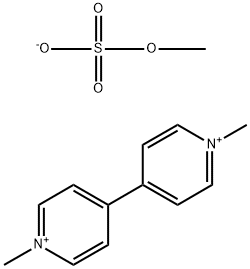Paraquat methosulfate
- CAS No.
- 2074-50-2
- Chemical Name:
- Paraquat methosulfate
- Synonyms
- Gramoone;paraquate;PARAQUATBIS;Weedol(Chevron);Dextrone-X(ICI);Bismethyl sulfate;Paraquat methosulfate;PARAQUAT-DIMETHYLSULFATE;Gramoxone methyl sulfate;Paraquat bis(methyl sulfate).
- CBNumber:
- CB6512251
- Molecular Formula:
- C13H17N2O4S+
- Molecular Weight:
- 297.35
- MDL Number:
- MFCD01941512
- MOL File:
- 2074-50-2.mol
| form | A solid |
|---|---|
| CAS DataBase Reference | 2074-50-2(CAS DataBase Reference) |
| EWG's Food Scores | 2 |
| FDA UNII | 8ZLR3D655F |
| EPA Substance Registry System | Paraquat methosulfate (2074-50-2) |
SAFETY
Risk and Safety Statements
| RIDADR | 2781 |
|---|---|
| HazardClass | 6.1(a) |
| PackingGroup | II |
| Toxicity | LD50 orally in male rats: 100 mg/kg (Kimbrough, Gaines) |
Paraquat methosulfate Chemical Properties,Uses,Production
Chemical Properties
Paraquat is a yellow solid with a faint, ammonia-like odor.
Uses
Herbicide. Dichloride as biological oxidation-reduction indicator.
General Description
White crystalline solid or yellow solid. Used as a contact herbicide and desiccant.
Reactivity Profile
When Paraquat methosulfate is heated to decomposition, Paraquat methosulfate emits very toxic fumes of sulfur oxides and nitrogen oxides. Avoid strong oxidizers. [EPA, 1998].
Health Hazard
Paraquat methosulfate can cause death by shock and/or pulmonary damage. The fatal dose is estimated to be 6 grams of paraquat ion. Exposure may cause renal tubular damage and liver dysfunction.
Fire Hazard
When heated to decomposition, Paraquat methosulfate emits very toxic fumes of sulfur oxides and nitrogen oxides. Avoid strong oxidizers.
Contact allergens
Paraquat is a quaternary ammonium compound with herbicide properties, as diquat. It is contained in Cekuquat? or Dipril?. It can cause contact and phototoxic contact dermatitis, acne, and leukoderma mainly in agricultural workers.
Safety Profile
Poison by ingestion and intraperitoneal routes. An herbicide. When heated to decomposition it emits very toxic fumes of SOx and NOx.
Potential Exposure
Those engaged in manufacture, formulation and application of this herbicide. Classified for restricted use: limited to use by a certified applicator, or those under applicator’s direct supervision.
Shipping
UN2781 Bipyridilium pesticide, solid, toxic, Hazard Class: 6.1; Labels: 6.1-Poisonous materials.
Incompatibilities
Incompatible with oxidizers (chlorates, nitrates, peroxides, permanganates, perchlorates, chlorine, bromine, fluorine, etc.); contact may cause fires or explosions. Keep away from alkaline materials, strong bases, strong acids, oxoacids, epoxides (hydrolysis), alkylarylsulfonate wetting agents. Corrosive to metals. Decomposes in presence of ultraviolet (UV) light. Decomposes in heat (see physical properties, above) and in the presence of UV light, producing nitrogen oxides, hydrogen chloride.
Waste Disposal
Paraquat is rapidly inactivated in soil. It is also inactivated by anionic surfactants. Therefore an effective and environmentally safe disposal method would be to mix the product with ordinary household detergent and bury the mixture in clay soil. In accordance with 40CFR165, follow recommendations for the disposal of pesticides and pesticide containers. Must be disposed properly by following package label directions or by contacting your local or federal environmental control agency, or by contacting your regional EPA office. Consult with environmental regulatory agencies for guidance on acceptable disposal practices. Generators of waste containing this contaminant (≥100 kg/mo) must conform with EPA regulations governing storage, transportation, treatment, and waste disposal.





